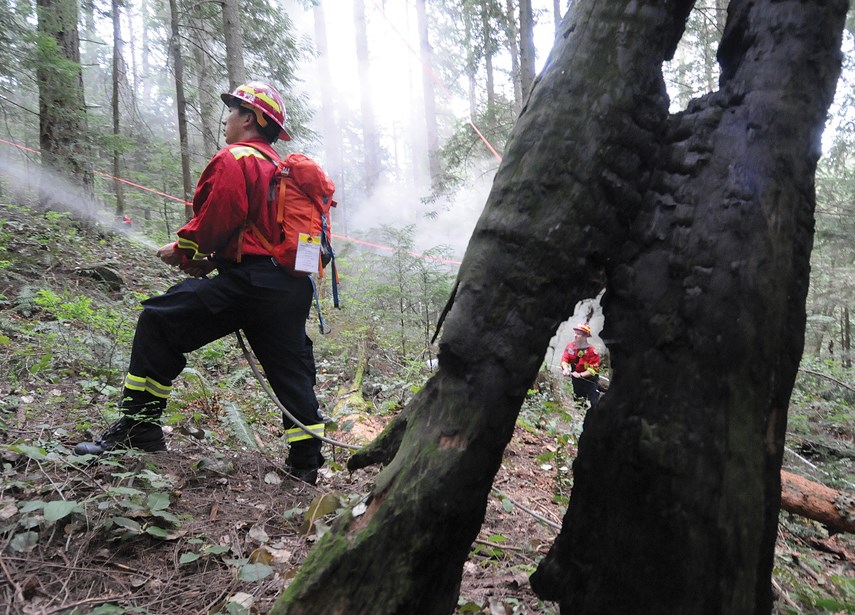It’s just before 8:40 a.m. when someone first smells the smoke coming from Kilmer Creek Park. The wildfire risk is high bordering on extreme, and officials have been tense. Despite many warnings, they’re still seeing people disregarding the danger – smoking and barbecuing in parks and on trails.
Within five minutes, a second fire has been spotted at Cypress Falls Park in West Vancouver. It’s spreading fast and threatening to jump to nearby homes.
Thankfully, these are only the shadows of things that may be. It’s the scenario North Shore Emergency Management chose for an all-hands-on-deck tactical wildfire suppression exercise, held Thursday.
“We are at increasing threat of wildfire on the North Shore due to climate change. We know that our region will continue to experience warmer, dryer and longer summers,” said Fiona Dercole, NSEM director. “I would say we have been lucky. We have had a number of small fires, and our fire and rescue services have been very responsive to suppress them quickly and that’s excellent. But as we saw in 2017 and 2018 where the provincial wildfire crews were extremely busy all over the province, there’s not a lot of local resources here on the coast when we’re in the midst of a heavy fire season. It makes us just a little bit more vulnerable.”
In the Kilmer Creek Park scenario, it was a half-hectare fire. Crews cut down hazardous trees and ran hoses into the woods to attack it from all sides, but to extinguish the fire they needed some help from above – specifically, a Talon helicopter bucketing water. Afterwards, the district’s extended operations unit came in to tamp down hot spots and the chopper took off for Cypress Falls.
In August 2018, a wildfire near Whyte Lake above Horseshoe Bay grew to three hectares in size and took four days to extinguish. That blaze was considered only small to medium sized.
“All fires start small and then grow,” Dercole said. “It grew more quickly than I think is normal fire behaviour for the North Shore. I think we were lucky there was a lake in close proximity.”
It’s the third time NSEM has run the operation but it’s the first time they’ve attempted putting out two simultaneous forest fires, a likely scenario following weeks of drought.
“We’re just wanting to strain our resources a little further to see how that goes and what our limits are,” Dercole said.
On Tuesday, police and bylaw officers from the municipalities conducted a mock evacuation in those neighbourhoods, going door to door, letting people know what they should be doing in the event of the real thing and distributing some materials on what they can do to help prevent forest fires.
Residents who live on the forest’s edge should have an emergency kit they can grab quickly, and evacuate. They should also have a family emergency plan that includes a place to stay with family or friends. For those who don’t have that option, NSEM will be practising setting up an emergency shelter to receive evacuees at Lynn Valley Baptist Church on Saturday.
Beyond strict adherence to provincial fire bans, residents living on the treeline should also consider using resistant roofing and siding on their homes, and use smarter landscaping like replacing cedar hedges with more fire resistant species.
Ultimately, Dercole feels we are in good hands.
“I feel quite ready. Our fire crews are very competent and have been working for this eventuality for a long time. We have the equipment. We have the training and we have the resources to respond effectively. This is a practice to hone that response. And we have excellent volunteers that can help to take care of the people.”



